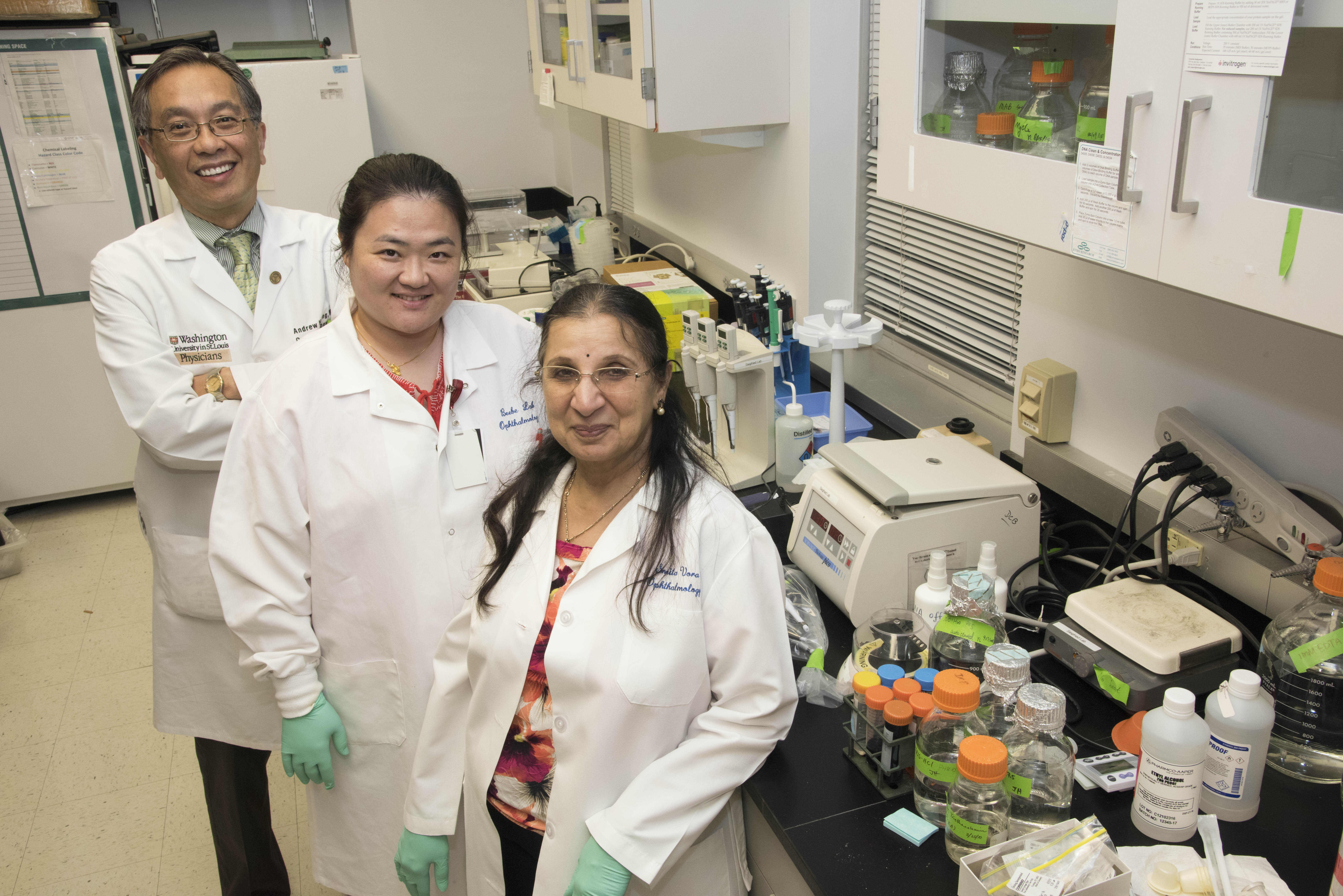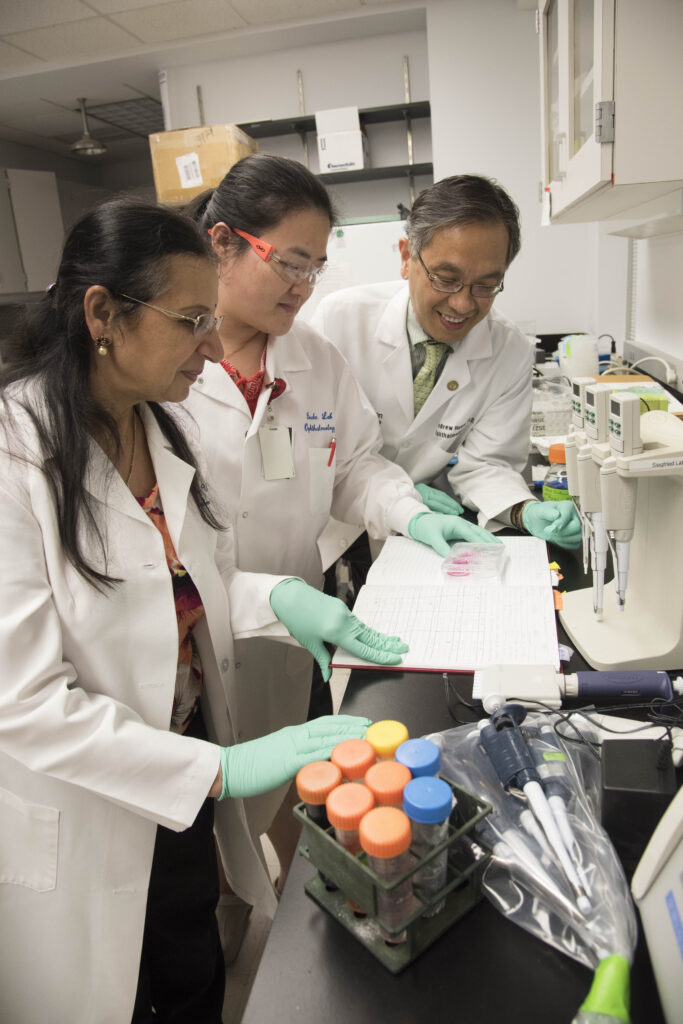Huang Lab
Andrew Huang, MD, MPH, Professor, Ophthalmology and Visual Sciences

Research
- Corneal epithelial wound healing
- Corneal neovascularization
- Corneal stromal dystrophies
- Corneal Stem cells and Dry eye

Corneal epithelial stem cells reside in limbus, a special structure located at the corneoscleral junction. Extensive ocular surface trauma or inflammation can often lead to loss of limbal stem cells, known as limbal deficiency. The hallmarks of limbal stem cell deficiency are conjunctival invasion of corneal surface, poor epithelial wound healing, corneal neovascularization and inflammation. The autologous or allogenic limbal stem cells can be cultivated and expanded in special tissue culture with various matrix carries including amniotic membrane. The expanded source may provide a viable corneal stem cell source for ocular surface rehabilitation.
Corneal epithelial/stromal dystrophies are a group of inherited corneal conditions characterized by abnormal protein aggregations with resultant corneal opacities and recurrent epithelial breakdowns. Mutations of keratoepithelin (KE), an extracellular matrix protein also known as TGFBI or BGH3 have been identified in the affected families. KE mutations can cause either amyloid formations (such as in various types of corneal lattice dystrophy) or amorphous aggregates (such as in corneal granular dystrophy or Avellino dystrophy). The molecular basis dictating the clinical phenotype has been unclear. The KE gene is located in human chromosome 5q31 and regulated by TGF-b (transforming growth factor- beta). This lab has previously identified the KE gene promoter. However, the activating mechanism of KE gene promoter has not been delineated. Studies on the regulation of gene promoter and related KE protein expression may reveal the pathogenesis of various corneal epithelial/stromal dystrophies and facilitate the development of novel therapeutic strategies for related corneal pathology.
RNA interference has been identified as a powerful tool for gene silencing. It can also be used to suppress expression of untoward genes of inherited conditions. We have developed several siRNAs (small interfering RNA containing short double-stranded RNAs) as a molecular silencer to knock down gene expression of KE and myocilin (a protein purportedly responsible for certain types of hereditary open-angle glaucoma), respectively. Using appropriate siRNA molecules, RNAi can selectively suppress the expression of KE and myocilin protein in vitro, respectively. Anterior segment of the eye is readily accessible for topical delivery of therapeutics to the target tissues such as cornea or trabecular meshwork. We are investigating the feasibility of delivering siRNAs to anterior segment as a new potential therapeutic strategy for inherited ocular conditions such as corneal dystrophies and glaucoma.
Publications
View all Andrew Huang’s NCBI publications on PubMed»
Peer-Reviewed Publications (*corresponding author)
- McDermott AM, Perez V, Huang AJW, Pflugfelder SC, Stern ME et al. Pathways of
corneal and ocular surface inflammation: a perspective from the Cullen Symposium. The
Ocular Surface 3:S131-138, 2005.
(Role: Participated in the group discussion, preparation of the draft and designs of
illustrations.) - Yuan C, Berscheit HL, Huang AJW*. Identification of an amyloidogenic region on
keratoepithelin via synthetic peptides. FEBS Lett 581:241-247, 2007.
(Role: Supervised the research projects and revised the manuscript.) - Yuan C, Zins EJ, Clark AF, Huang AJW*. Suppression of keratoepithelin and myocilin by
small interfering RNAs (siRNA) in vitro. Mol Vis 13:2083-2095, 2007. (Role: Supervised
the research projects and wrote the paper.) - Huang AJW*. Suppression of keratoepithelin and myocilin by small interfering RNA (an
American Ophthalmological Society thesis). Trans Am Ophthalmol Soc 105:365-378,
2007. (Role: Conceived the research, supervised the research projects and wrote the
manuscript.) - Iuorno J, Truskinovsky A, Chung G, Krachmer J, Bawcombe D, Huang A. Conjunctival
condylomata acuminata. Cornea 27:621-624, 2008. (Role: Conceived the research,
provided clinical care and supervised the research.) - Segal B, Thomas W, Rogers T, Leon J, Hughes P, Patel D, Patel K, Novitzke J, Rohrer M,
Gopalakrishnan R, Myers S, Nazmul-Hossain A, Emamian E, Huang A, Rhodus N, Moser
K. Prevalence, severity, and predictors of fatigue in primary Sjogren’s syndrome. Arthritis Rheum 59:1780-1787, 2008. PMID: 19035421 (Role: Provided clinical services and
relevant data collection.) - Yuan X, Wilhelmus KR, Matoba AY, Alexandrakis G, Miller D, Huang AJW.
Pathogenesis and outcome of Paecilomyces keratitis. Am J Ophthalmol 147:691-696, 2009.
PMID: 19195638 (Role: Provided clinical care and relevant data collection for this
collaborative research. - Patel DA, Chang SH, Harocopos GJ, Vora, SC,
Thang DH, Huang AJW. Granular and
Lattice Deposits in Corneal Dystrophy Caused by R124C Mutation of TGFBIp. Cornea
2010 (in press). NIHMSID #198702, Publ.ID:ICO201682 - Edelstein SL, Huang AJW, Harocopos GJ, Waltman SR. Avellino corneal dystrophy with
R124C mutation in TGFBI gene. Cornea 2010 (in press) - Council MD, Huang AJW. Editorial on “Modified Deep Lamellar Keratoplasty for the
Treatment of Advanced-Stage Keratoconus with Steep Curvature”. EBO 2010 (in press).
Book
- External Disease and Cornea: Basic and Clinical Course, Section 8. American Academy of
Ophthalmology, San Francisco, CA (Co-editor, 1996-2001)
Book Chapters
- Chung GW, Iuorno JD, Huang AJW. Dry Eye Syndrome Update II, Corneal/External
Disease Subspecialty Clinical Updates, Volume 1, Module 7,
www.aao.org/aao/education/scu American Academy of Ophthalmology, 2005. - Dahlgren MA, Dhaliwal A, Huang AJW. Persistent epithelial defects. In, Albert D, Miller
J, Azar D, Blodi B (eds). Albert and Jakobiec’s Principles and Practice of Ophthalmology,
3rd edition, pp 749-759, 2008. - Li D-Q, Pflugfelder SC, Huang AJW. Ocular surface epithelial stem cells. In, Low WC,
Verfaillie CM (eds.). Stem Cells and Regenerative Medicine. World Scientific Publishing,
Chapter 6, pp111-144, 2008. - Sun R, Vitiello V, Huang AJW. Gram-positive aerobic rods. In, Tasman W, Jaeger EA
(eds). Duane’s Foundations of Clinical Ophthalmology. Lippincott Williams & Wilkins.
Vol 2, Chapter 51. (in press, 2010) - Edelstein SL, Wichiensin P, HuangAJW. Bacterial keratitis. In, Krachmer JH, Mannis
MJ, Holland EJ (eds). Cornea, 3rd edition. Elsevier-Mosby, Inc. Chapter 77, pp 10xx-10xx,
2010.
Scientific Abstracts
- Huang AJW, Yuan C. Single nucleotide polymorphism in the BIGH3 gene promoter in a
case of presumed corneal lattice dystrophy. ARVO Program Summary Book:271, 2006. - Yuan C, Huang AJW. Abnormal aggregation of mutant BIGH3 proteins in vitro. ARVO
Program Summary Book: 256, 2006. - Berscheit HL, Yuan C, Huang AJW. TGF-b1dependent Up-regulation of keratoepithelin
is mediated via Smad. ARVO Program Summary Book: 282, 2007. - Yuan C, Little MR, Berscheit HL, Huang AJW. Mechanisms of amyloid fibril formation
for keratoepithelin. ARVO Program Summary Book:105, 2008. - Neusidl W, Saad HAH, Hannush SB, Belin MW, Huang AJW, Lubniewski AJ.
Minimizing endothelial cell loss during DSEK utilizing a novel corneal inserter.
EBAA/Cornea Society meeting Abstract Book:5, 2008.
Other Scientific Presentations
- Comparisons between oblique keratotomy a radial keratotomy. First International
Symposium of Ophthalmology, Bourdeaux, France, Sept. 10, 1993. - Recognition and treatment of acute retinal necrosis. Annual meeting of American Academy
of Ophthalmology, San Francisco, CA, Nov. 5, 1994. - Expression of matrix metalloproteinases (MMPs) in vascularized and transdifferentiated
rabbit corneal epithelia. Annual meeting of Association of Research in Vision and
Ophthalmology. Ft. Lauderdale, FL, April 30, 2001. - Pseudopterygium: Idiopathic limbal deficiency. 7th International Ocular Surface Society.
Ft. Lauderdale, May 4, 2002. - Single nucleotide polymorphism in the BIGH3 gene promoter in patients with presumed
corneal lattice dystrophy. Annual meeting of Association of Research in Vision and
Ophthalmology. Ft. Lauderdale, FL, May 4, 2006.